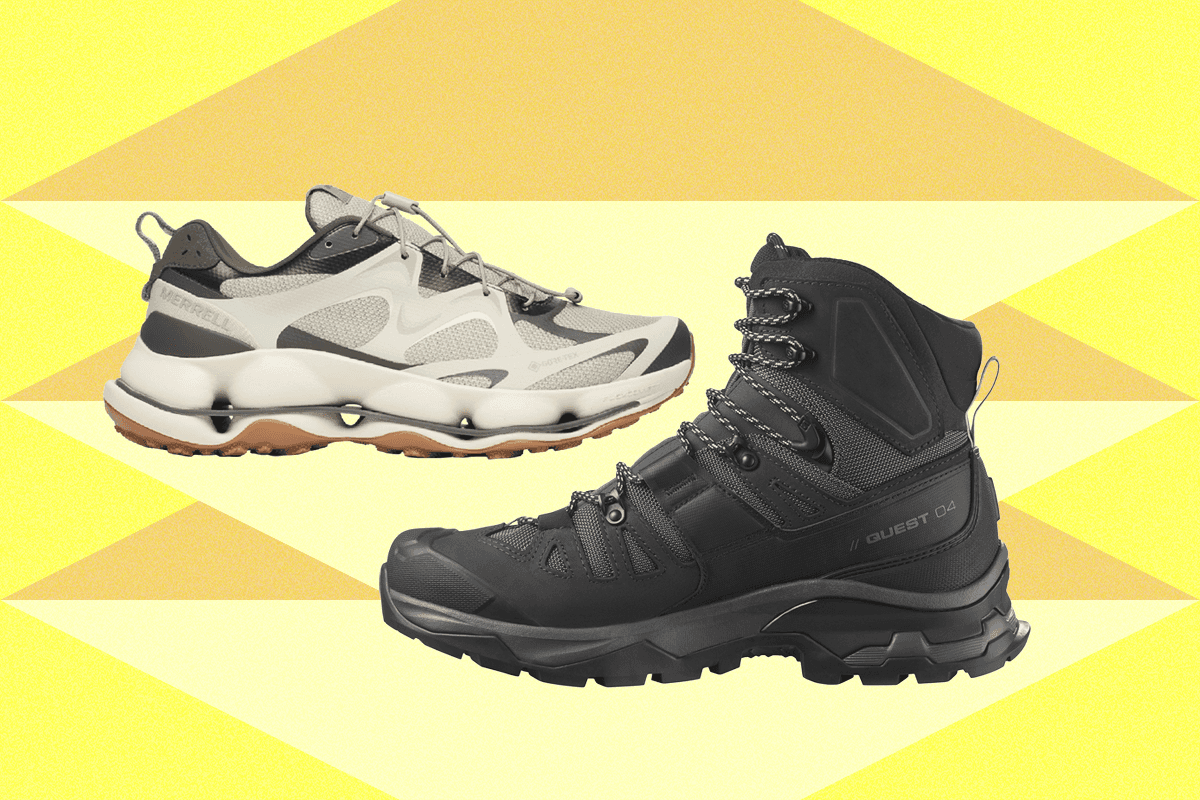When I started hiking, big leather boots were the only real option. They were burly, stiff, and difficult to break in, but one pair would last you decades. Technology has mercifully caught up, however. If you head to the trails today, most hikers and backpackers are opting for more lightweight, low-cut options. While an influx of new shoes from brands like Hoka, Merrell, Danner, and Salomon has transformed the footwear industry, that doesn’t mean the hiking boot has had its day. It just depends on what you’re looking to do and when you’re doing it.
Which shoes should you pick to go out for the day? I tested countless pairs of great hiking boots, trail runners and hiking shoes, across a variety of terrain, from forest trails and coastal paths, to high alpine terrain. To get a better understanding of the differences between the many options available—and which is right for you—I grilled Ingrid Johnson, a leading footwear product specialist at REI. (For what it’s worth, Johnson’s personal recommendation is the Salomon XA Pro).
When you’ve chosen your next pair of trail running shoes (or hiking boots), be sure to check out more of WIRED’s outdoor guides, like the Best Running Shoes, Best Puffer Jackets, and Best Hiking Backpacks.
Here’s When You Need Boots
If you’re carrying a heavy pack over rough terrain, or if it’s wet or snowy, you need hiking boots. They tend to be higher at the ankle, with stiff midsoles, protective toe caps, and are generally made from very durable materials like leather and tough synthetic fabrics like Cordura. Hiking boots prioritize stability, protection, and durability.
Boots generally have thick, deep lugs, tougher soles, stronger toe guards, sturdier ankle support. They protect you from rock impact, uneven ground, moisture, and often colder conditions. The high cut designs also offer more ankle support, something I found reassuring when coming back from a recent injury.
But don’t think that hiking boot brands are stuck in the dark ages. Borrowing lightweight features and materials from trail running, brands are able to offer technical boots with cushioning, grip and stability. They’re still heavy, but featherweight compared to a traditional leather boot. Hoka’s Kaha 3 GTX ($240) is one of the best boots available, blending soft nubuck leather, Vibram Megagrip sole and bags of cushioning. Here are a few other picks.
Perennially popular for good reason, these Salomons boast superb levels of comfort and support without the bulk typically associated with traditional walking boots. They feel like ski boots, but that’s not a criticism, the height and support is most welcome when walking all day carrying a full pack.
The suede leather and rubberized toe-cap make them impressively robust, they’re easy to clean, and the Gore-Tex liner offers complete waterproofing. The outsole is deep, aggressive, and impervious to unexpected slips, and top marks go to the metal lacing system, especially the middle eyelet that grips the laces securely. They’re not as forgiving underfoot as many of the newer running-shoe-inspired designs, but there’s plenty of shock absorption in the ball and heel.
You pay handsomely for the privilege, but the Kopec is a hugely versatile, waterproof boot for all seasons. Made from 100 percent nylon Cordura, the upper is very durable and gives the boot quite a stiff, secure feel, despite weighing just 11.9 ounces for a size eight.
Designed for day hikes over varied terrain, they impressed me with a great mix of stability and cushioning. If you’re not a fan of the pillowy feel of trail running shoes, these hit the sweet spot. They have out-the-box comfort, which is rare with a stiffer boot, and they feel really secure when scrambling and walking. The security in the heel and ankle is matched by a Vibram Megagrip rubber sole with mud loving 4-mm lugs. I’m a big fan of this rubber compound, and here the lugs have been arranged to give the most grip for the least weight.
After months of regular wear—on and off the trails—they still look remarkably fresh, and I appreciate being able to simply hose them down to wash away the mud. Yes they’re expensive for day hikers, but the materials used do offer a genuine crossover between old and new designs, without compromising on style or performance.
Mammut
Kento Tour High GTX
Serious alpine terrain demands respect, and if you’re going to be encountering snow, ice, rocks and steep climbs, you need a mountaineering boot. Weighing 1 pound, 5.8 ounces per boot (9.5) the Kento Tour, from Swiss pioneers Mammut, offers a surprisingly agile mix of stiff soled support, grip and protection. Given the height and stiffness, it’s a remarkably comfortable boot, and despite the big 11 millimeter drop, it’s easy to stick to your natural stride.
This is about as far from a trail running shoe as you can get—it’s crampon-compatible, for one thing—but it does have out-of-the box comfort, and just enough flex to stop it feeling like a ski boot. Gore-Tex takes care of the waterproofing, and the velour leather upper and approach shoe style lacing system means you can really dial in the fit.
Tested on a snow covered glacier in freezing conditions, I was impressed by the warmth offered, and the Vibram Hexa Tech sole made me feel more mountain goat than amateur mountaineer. I’ve also used these boots on scrambling rocky ascents, and they just instill confidence in every step.
Here’s When You Need Trail Runners
If you’re on a day hike, carrying a daypack, and moving quickly, you’re much likelier to be happier in trail runners. Trail running shoes are much lighter, more flexible, and built for speed or covering long distances fast. They have more breathable uppers and softer, more cushioned midsoles.
Most trail running brands offer a choice of waterproof (typically Gore-Tex) or breathable models. Breathable options are ideal for dry weather, and if you’re running distances, as they drain quickly if you have to get wet. Waterproof options are great for splashing through puddles, but they do trap heat, which is great in the winter but sweaty in the summer.
It’s worth noting that not all trail running shoes are great for hiking. Just as carbon plates are wasted on daily trainers, other features are a waste when you will be mostly walking, instead of running. I love the lightweight feel, grip and cushioning of the Adidas Terrex Agravic Speed ($160), but the rocker design only really works when you’re running, not walking.
The Best Trail Runner (for Me)
I’m not going to run a hundred-mile race or chase UMTB podiums, so on paper the race-focused, ultra endurance Hoka Mafate X are not for me. I do not care. They are impossibly comfortable and the enormous 49-mm heel dual density foam cushioning (with an 8-mm drop) make them nimble and fun to wear almost anywhere.
The sole is made from the ever-reliable Vibram Megagrip, and the 4-mm lugs grip well. The forked carbon fiber plate adds a propulsive feel, making climbs and descents, at walking or running pace appreciably less punishing. I’ve worn these shoes for countless hours across all surfaces, and my feet and legs remain remarkably fresh.
They’re not designed for hiking, and some people might dislike the fact you feel very little underfoot, but personally, I can’t get enough of that sensation. The protective cushioning encourages me to go further, and smooths out the path ahead. Yes, they’ll be a bit wobbly if you’re balancing along ridgelines, or needing to be precise, but when the path’s clearly marked, these will triumph. Annoyingly, they are expensive. Despite some nice toe protection, and a decent sole, they wear much more like a sneaker than a boot.
A Great Do-It-All Trail Runner
Salomon
Aero Blaze 3 GRVL GORE-TEX Trail Running Shoes
Salomon has pimped up their excellent Aero Blaze 3 road running shoe and turned it into a multipurpose, multi-surface design. The GRVL moniker refers to gravel, and the idea that, like a gravel bike, the shoes can go anywhere. Yes, it’s a marketing ploy, but one I’ve been impressed with so far (Craft is also leaning into it with the excellent Xplore 2 ($150) and one that should help reduce clutter in the shoe cupboard.
The most noticeable change here is the Gravel ContaGrip outsole with lovely, deep chevron-shaped lugs that work on everything from dirt trails and grass to slippery roads. They’re not designed to cope with deep mud or technical rocky climbs, but the reinforced toe area does provide a bit of protection. I live one mile from a forest and, unlike wearing many trail running shoes, I do not hate my time on the asphalt.
The 8-mm drop, foam midsole, and gentle reverse camber shape offers plenty of cushioning, and a nice smooth journey. They lack the plushness of the Hoka Mafate X, but foot fatigue is minimal. They’re not specifically aimed at hikers, but I’ve had no issues wearing them on weekend walks, runs and trips to the shops. The Gore-Tex upper keeps my feet dry too, although the white sample I’ve been wearing didn’t stay that way for long.
A Zero-Drop Thru-Hiking Classic
Altra
Lone Peak 9 Waterproof Low
The Altra Lone Peak shoe first launched in 2011 and now has a cultish following, particularly with thru-hikers looking to go the distance. Weighing 11.15 ounces for men’s (9.3 ounces for women’s), the shoe is light and comfortable, and the reinforced toe and heel offers excellent protection from nature’s trip hazards. I tested the waterproof version (non waterproof are $20 less), which survived sloppy puddles and grass, and was impressed by the neat little Velcro strip on the heel for attaching gaiters.
Being an Altra, it’s a zero-drop design and has a super wide toe box to encourage natural movement. While this does give the sneaker a rather orthopedic look, the comfort is hard to argue with. As someone developing bunions from too many hours in climbing shoes, the Lone Peak 9 are a blessed relief. Be warned though, you will need to train your legs to adapt to a zero-drop design before taking on any serious distances.
The midsole here doesn’t offer super-shoe levels of cushioning, and that’s no bad thing, as they remain balanced and responsive over all types of terrain. There’s a rock plate too, which really makes a difference. The MaxTrac rubber outsole grips well in mixed condition, and the 3.5 millimetre lugs are well positioned and eat up the trail. There is also a marginally heavier Lone Peak 9+ ($155) which has a Vibram Megagrip sole for even greater grip.
Columbia
Konos Trillium ATR
While not advertised as such, the Columbia Konos Trillium ATR looks and feels like a trail running shoe, and in my experience, can happily do both, assuming you’re not looking to try and win the Barkley Marathon. But they are good for long days on mixed terrain and at 11.9 ounces per shoe (US men’s 9) they’re light, yet still feel more supportive than a dedicated runner.
The midsole borrows the most from running tech, with plush cushioning and an 8 millimeter drop that helps smooth out your stride, even when the trail turns rocky or loose underfoot. Yes, the added squish does impact on stability if you’re a heel striker, but they’re great on packed dirt, gravel and woodland paths.
They’re not perfect for everything. On very wet or technical terrain, I’d want more side support and stiffness, and if I were carrying a heavy pack over multiple days, I’d still choose boots. But for faster hikes, day trips and mixed-surface adventures, they’re a great shoe at a great price.
Here’s When You Need Hiking Shoes
If you’re moving through technical terrain—lots of gravel or scree, anything where your foot placement really matters—you should consider a hiking shoe. Hiking shoes are sort of a middle ground between boots and trail runners. They’re more flexible than full boots, but stiffer than trail runners. They often share many protective features from boots including thick soles, good toe protection and liberal use of leather and tough synthetic materials. They are however generally more agile and comfortable, with a quicker break-in period.
They’re also heavier than trail runners, but much lighter than boots. What you lose in speed, you tend to gain with added support. The soles too tend to be stiffer than trail runners, and lack the plush responsiveness. This isn’t always the case, as I discovered with the Merrell Speedarc Matis GTX ($210), which blends the two features well.
Hiking shoes offer good protection from rocky terrain and tree roots, with thicker soles and reinforced toe bumpers keeping your feet from harm, but they are still vulnerable to deep puddles or snow. Trail running shoes are often designed for enhanced breathability, and drainage, so you can run through streams and shed water quickly. This is great if you are actually running, as they will dry quickly, but a bit soggy for a casual hike.
Merrell
Speedarc Matis GTX
Available in a non-waterproof shoe, GTX, and mid-height Gore-Tex boot, these futuristic-looking hiking shoes from Merrell might not appeal to a traditionalist, but they are extremely capable across a huge variety of terrain. At 12.87 ounces for a US 9, they’re quite heavy—especially compared to trail runners—but they have a surprising amount of heft to them and excellent Vibram MegaGrip outsole with mud-shelling 3 millimetre lugs that are great on slippery roots, gravel, trails, grass and generally scrambling about.
There’s a plate included here between the funky two-part midsole, which makes the shoe quite stiff—again, compared to trail runners—and I love it. It’s rare to find a combination of trail running plushness with the security of a stiffer hiking boot. I’d not suggest you carry a heavy pack over rocky terrain for days with them, but they’re a great option for moving fast on the trails, with your feet well protected. They look like a cool trail running shoe too, so you can still look good popping out for your Cortado.
It’s a bold design departure for Merrell, who has a brilliant track record making boring but brilliant hiking shoes and boots. The Moab Speed 2 GTX ($170) remains a firm favorite, and while they lack the ‘trail running’ aesthetic they’re padded, grippy and offer all-day stability.
A Breathable Hybrid Hiker
They look big on my feet, but impressively weigh a mere12.64 ounces per shoe (US men’s 8) while still offering the plushest level of cushioning, and confidence boosting support across a wide range of terrain. They also have excellent breathability, which makes them ideal for dry, warm weather adventures and breezy toes.
Given the chunky dimensions some might be tempted to size down, but in truth, I’d actually take at least half a size up. My US 11 sample had generous width, but only just enough length, which is unusual. Once you’ve found your size, though, the shoe’s Vibram MegaGrip sole and well-organized 5-mm lugs provide superb traction. Hoka has also incorporated a 100 percent recycled polyester upper here, as well as a sockliner made with 50 percent soybean oil.
The Anacapa Breeze Low (also available in a GTX waterproof model) are a few years old now, and as such, often heavily discounted. They look enough like trail runners for you to keep up (in the style stakes) with the cool kids.
A Brilliant Day Hiking Shoe
I’ve tested at least 40 pairs of hiking boots, shoes and trail runners since I first wore these Danners, yet they remain a regular for trips out, day hikes and general mooching about. I wouldn’t hike the 2,650 miles of the Pacific Crest Trail in them, despite being named after it, but they are comfortable and supportive, with impressive protection underfoot from rocks and uneven ground.
On the heel, you’ll notice a funny plastic bumper. This is actually a clever way to add lateral stability without impacting on comfort. I’ve had no issues with either, so I have to assume it works. Danner offers a Gore-Tex option here, which I’ve also tested, but the membrane did make the shoe stiffer, and tighter, so maybe go half a size up. My preferred upper is made from suede that softens over time, molding to my foot. It also looks great, although it does hold onto the water if wet, unlike the latest trail runners.
Keen
Zionic NXT Waterproof Hiking Boot
At 13.4 ounces per shoe, these new style Keen aren’t as featherweight as the Arc’teryx Kopex, but they do have a more trail runner style feel, despite the ankle height. They’re agile, with plenty of spring from the midsole, with the added bonus of a bit of support over uneven ground. They’re not a pretty shoe, but performance is impressive nevertheless.
They’re far less clunky than a traditional boot, but solid enough that I never get compromised on slippery or technical surfaces, and the Keen-Dry waterproof membrane hasn’t failed me yet. The multidirectional 4-mm lugs gripped well on slippery autumnal trails, and I liked the inclusion of traditional boot eyelets. It’s a small detail., but one that makes getting higher boots on much easier.
Over a four hour hike without any prior breaking in, I found the cushioning is forgiving, with no hotspots, and the toe box generous. I’ve only tried the mid-height option, but imagine the low design is equally as comfortable and will feel even more like a well supportive trail runner.
What’s an Approach Shoe?
Adding another option to the outdoor footwear mix, approach shoes are hybrid walking shoes with technical features borrowed from climbing shoes. They’re specifically made to tackle the technical approach to the start of a rock climb and boast sticky rubber outsoles which grip well on rock.
Climbing brands like La Sportiva, Scarpa, and Arc’teryx offer these shoes but the fit is slightly different. Senior commerce editor Adrienne So loves these because the fit is snug, so you can wear them on the iffiest terrain, and there’s not much cushioning (which feels much better if you’re used to wearing barefoot-style shoes). The lack of cushioning and the protective rubber rand is good if you like a versatile shoe that can work for multiple outdoor sports, like skateboarding and mountain biking.
The Black Diamond Prime that she recommends here also has a stomp-down heel which makes it an ideal camp shoe for slipping on and off easily.
FAQs
What factors matter most when considering which pair of shoes you should get?
I consulted Ingrid Johnson from REI who noted a couple of key factors that are important to consider. Durability is important. Johnson notes that “trail running shoes tend to wear out faster than hiking boots, especially ones with a foam midsole like a road running shoe rather than a harder rubber sole.” Leather also tends to last longer than fabric uppers, especially mesh.
Trail running shoes are typically made from fabric and boots, typically leather, but there is some overlap between categories. Some hiking shoes are almost identical to boots, just without the mid-height ankle. Approach shoes have the shortest lifespan, especially on the sole, as the sticky rubber wears out fast. The soles are thinner and offer more direct contact with the rock.
The faster you are trying to move or the more miles you are trying to cover in a day, the more the weight of your shoes matters, as extra ounces on your feet add up to thousands of reps for your hip flexors. However, Johnson says, “it is not worth sacrificing function just to shave weight, for boots or any other type of gear. If your fitness level, pack weight, body weight, or the terrain call for more stiff, supportive footwear, you will be more comfortable and perhaps actually able to travel faster because you are more confident in your footing compared to going with too light a shoe.”
Hiking boots weigh around 2.5 to 3-plus pounds per pair, while trail running shoes start from around 1 to 1.5 pounds. Ultralight models like the Nnormal Kjerag 01 for $140 weigh just 8 ounces per shoe for a size 9, but don’t expect them to last as long as those with greater levels of protection.
Power up with unlimited access to WIRED. Get best-in-class reporting and exclusive subscriber content that’s too important to ignore. Subscribe Today.







